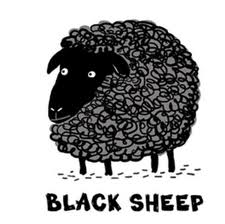A team of researchers led by Blacksheepologist, Sophy M. Laughing, Ph.D., claim to have uncovered the true origin of the elusive Black Sheep.
In ancient times, people relied on themselves or their local communities to help them recognize a Black Sheep. When Tribal Chiefs tried to describe Black Sheep to warriors, it became imperative to answer one question: what is it that identifies someone as a Black Sheep?
The questions surrounding the true identification of Black Sheep have long since troubled humanity. “What is it that remains constant from the cradle to the cave?” asked Dr. Laughing, in a recent conference on The Existence of Black Sheep: The Woolly Coat Mystery.
One particularly disturbing piece of evidence regarding Black Sheep comes from a 1.6 million year old case of identity theft in Tanzania.
A stone hand axe, used by the Olduvai Gorge Gang, was discovered and linked to the preparation of White Sheep hides, which were then mass-produced into counterfeit black hides. Using a reddish-brown color from an ochre pigment, the skin was then mixed with animal fat to create a Black Sheep look; while elegant and stylized instructions on how to behave badly were painted onto cave walls. According to Laughing, this is the earliest known reference to Black Sheep Identity Theft by means of impersonation.
Thanks to the recent discovery of the Black Sheep Scrolls by Laughing and her team, analyzing previously incomplete data by identifying the meanings behind the hides, as well as other objects, represents an important window in understanding which features were inherent to Black Sheep and which features were adopted by their impersonators.
Alphonse Bertillon (April 24, 1853 – February 13, 1914), the French police officer and biometrics researcher who created anthropometry (an identification system based on physical measurements), created a mug shot of the infamous Black Sheep based off of historical text. Before this time, Black Sheep could only be identified based on unreliable eyewitness accounts. This method was eventually supplanated by Francis Galton’s hoof printing and Sir Alec Jeffreys of Leicester University’s Black Sheep-DNA Code (BS-DNA).
Embedded in this short history is all the elusiveness of Black Sheep identity; each new advance reveals the flaws in earlier systems of identification.
Ironically, our facility for recognizing Black Sheep may be to blame for many of the misidentification accounts. The brain has evolved to look for patterns of bad behavior, and when one a concept is found incomplete it will fill in the gaps, sometimes leaping to the wrong conclusion.
BS-contamination is vast becoming a serious issue. When technology allows for a Black Sheep’s entire genome to be read from a single drop of blood, it may well constitute a gold standard for Black Sheep identification. But for now analysts work with a snapshot of that genome, represented by an arbitrary number of markers spaced along it. If there are gaps to be filled, the brain will do so, which could make BS-DNA vulnerable to the same kind of interpretation errors as expressed by its predecessors.
Perhaps identifying Black Sheep, like beauty, lies in the eye of the sheepherder. If people want to know whether they or a family member is descended from a Black Sheep, they can now look to Laughing’s work for at least some of those answers.
The best way to learn about the origin of Black Sheep is to analyze Dr. Laughing’s field notebooks. Laughing’s notes and observations relate six methodologies that can be used in various permutations and combinations to analyze Black Sheep. These methodologies are:
Super Black Sheep and the Unconscious
Black Sheep Signs and Symbols
Black Sheep Etiquette: A Matter of Taste
The Black Sheep Economist
The Anthropology of Black Sheep
Black Sheep Archaeology
“A purely theoretical approach in determining the true origin and nature of Black Sheep is tricky business,” explains Laughing. “I thus offer further interpretations on a number of Black Sheep artefacts based on theories I’ve explicated and by looking to other disciplines.”
Each methodology is separated into separate notebooks, with the seventh notebook consists mostly of drawings. Laughing concludes each discussion of an artefact by shedding light on the utilitarian aspects of the objects.
“These objects allow us to see more easily the bond of communication that links an objects to any given personality. The power of these objects bring out into the open new aspects of the Black Sheep’s personality, which is a key element in both identification as well as accurate analysis of remains.”
Given the longstanding challenges in identifying Black Sheep, it is important to distribute Laughing’s findings to a broader audience. As you will see, Black Sheep culture is a subject of interest to people everywhere.

















No comments:
Post a Comment